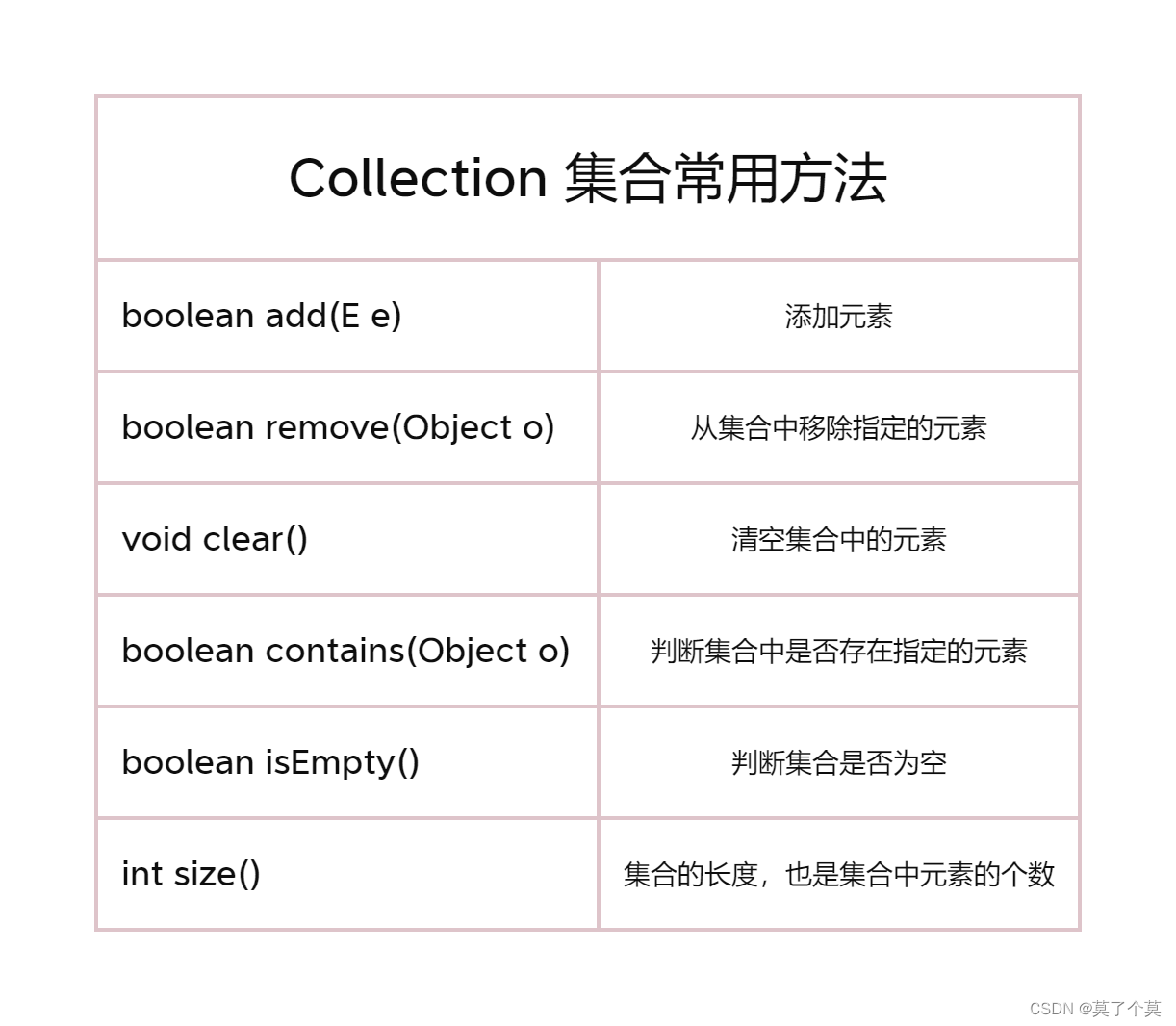目录
思维导图

1 Collection
1.1 集合知识回顾
集合类的特点:提供一种存储空间可变的存储模型,存储的数据容量可以随时发生改变
1.2 集合类体系结构

1.3 Collection 集合概述和使用
Collection集合概述
● 是单列集合的顶层接口,它表示一组对象,这些对象也称为Collection的元素
● JDK 不提供此接口的任何直接实现,它提供更具体的子接口(如Set和List)实现
创建Collection集合对象
● 多态的方式
● 具体的实现类 ArrayList
示例代码:
public class test {
public static void main(String[] args) {
//创建Collection集合对象
Collection<String> c = new ArrayList<String>();
//添加元素,boolean add(E e)
c.add("hello");
c.add("world");
c.add("java");
//输出结果
System.out.println(c);
}
}1.4 Collection 集合常用方法

补充:Alt + 7 可以打开一个 窗口,可以看到所有类的信息
示例代码:
public class Test_01 {
public static void main(String[] args) {
//创建一个Collection集合对象
Collection<String> c = new ArrayList<String>();
//boolean add(E e):添加元素
c.add("hello");
c.add("world");
c.add("java");
//boolean remove(Object o):从集合中移除指定的元素
// System.out.println(c.remove("world"));
// System.out.println(c.remove("javaee"));
//void clear():清空集合中的元素
// c.clear();
//boolean contains(Object o):判断集合中是否存在指定的元素
// System.out.println(c.contains("world"));
// System.out.println(c.contains("javaee"));
//boolean isEmpty():判断集合是否为空
// System.out.println(c.isEmpty());
//int size():集合的长度,也是集合中元素的个数
System.out.println(c.size());
//输出集合
System.out.println(c);
}
}
1.5 Collection 集合的遍历
Iterator:迭代器,集合的专用遍历式
● Iterator<E> iterator() :返回集合中元素的迭代器,通过集合的iterator()方法得到
● 迭代器是通过集合的iterator()方法得到的,所有我们说它是依赖于集合而存在的
Iterator中的常用方法
● E next():判断集合中是否存在指定的元素
● boolean hasNext():如果迭代具有更多元素。则返回true
示例代码:
public class Test_02 {
public static void main(String[] args) {
//创建Collection集合对象
Collection<String> c = new ArrayList<String>();
//添加元素,boolean add(E e)
c.add("hello");
c.add("world");
c.add("java");
Iterator<String> it = c.iterator();
while(it.hasNext()){
String s = it.next();
System.out.println(s);
}
}
}
1.6 集合的使用步骤

案例:Collection 集合存储对象并遍历
需求:创建一个存储学生对象的集合,存储3个学生对象,使用程序实现在控制台遍历该集合
示例代码:
//学生类
public class Student {
private String name;
private int age;
public Student() {
}
public Student(String name, int age) {
this.name = name;
this.age = age;
}
public String getName() {
return name;
}
public void setName(String name) {
this.name = name;
}
public int getAge() {
return age;
}
public void setAge(int age) {
this.age = age;
}
}
//测试类
public class Test {
public static void main(String[] args) {
Collection<Student> students = new ArrayList<Student>();
Student s1 = new Student("jack",20);
Student s2 = new Student("mary",21);
Student s3 = new Student("jane",22);
students.add(s1);








 最低0.47元/天 解锁文章
最低0.47元/天 解锁文章















 942
942











 被折叠的 条评论
为什么被折叠?
被折叠的 条评论
为什么被折叠?








